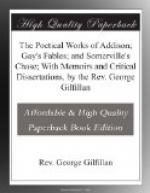On the 2d of January 1711, the last Tatler came forth; and on the 1st of the following March appeared the Spectator, which is now the main pillar of Addison’s fame, and the fullest revelation of his exquisite genius. Without being as a whole a great, or in any part of it a profound work, there are few productions which, if lost, would be more missed in literature. One reclines on its pages as on pillows. The sweetness of the spirit,—the trembling beauty of the sentences, like that of a twilight wave just touched by the west wind’s balmy breath,—the nice strokes of humour, so gentle, yet so overpowering,—the feminine delicacy and refinement of the allusions,—the art which so dexterously conceals itself,—the mild enthusiasm for the works of man and God which glows in all its serious effusions,—the good nature of its satire,—the geniality of its criticism,—the everlasting April of the style, so soft and vivid,—the purity and healthiness of the moral tone,—and the childlike religion which breathes in the Saturday papers—one or two of which, such as the “Vision of Mirza,” are almost scriptural in spirit and beautiful simplicity,—combine to throw a charm around the Spectator which works of far loftier pretensions, if they need not, certainly do not possess. Macaulay (whom we love for his love of Addison and Bunyan more than for aught else about his works) truly observes, that few writers have discovered so much variety and inventiveness as Addison, who, in the papers of a single week, sometimes traverses the whole gamut of literature, supplying keen sarcasm, rich portraiture of character, the epistle, the tale, the allegory, the apologue, the moral essay, and the religious meditation,—all first-rate in quality, and all suggesting the idea that his resources are boundless, and that the half has not been told. His criticisms have been ridiculed as shallow; but while his lucubrations on Milton were useful in their day as plain finger-posts, quietly pointing up to the stupendous sublimities of the theme, his essays on Wit are subtle, and his papers on the “Pleasures of Imagination” throw on the beautiful topic a light like that of a red evening west, giving and receiving glory from the autumnal landscape.
In the end of 1712 the Spectator, which had circulated at one time to the extent of 4000 copies a-day, was discontinued, and in a few weeks the Guardian supplied its place. It was two months ere Addison began to write, and during that time it was flippantly dull; but when he appeared its character changed, and his contributions to the new periodical were quite as good as the best of his Spectators.




